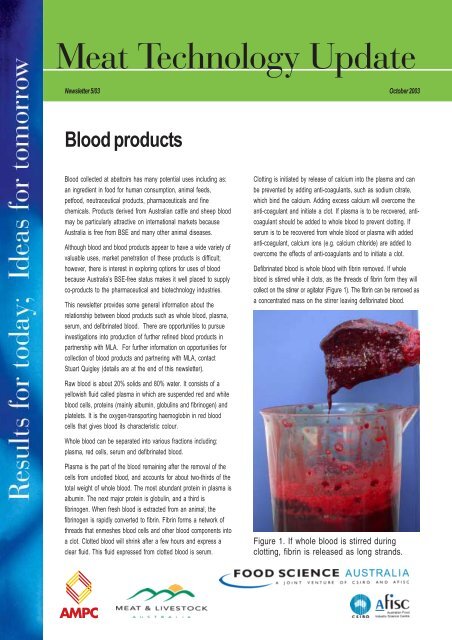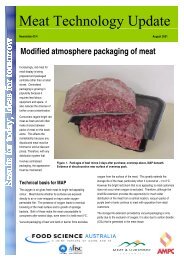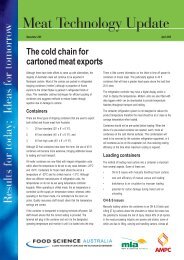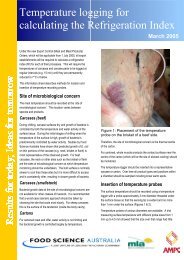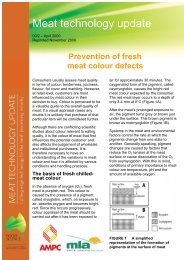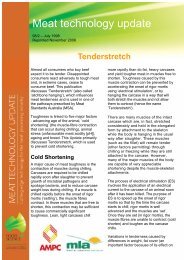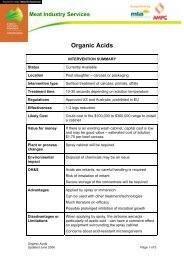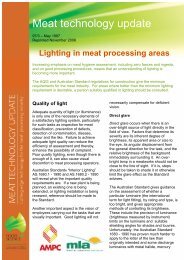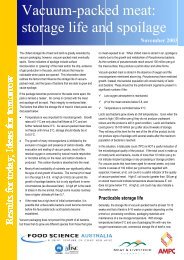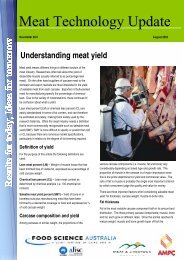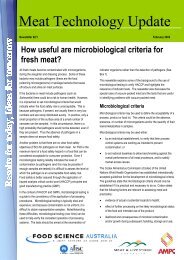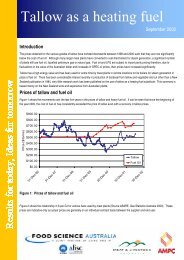Blood products. - Red Meat Innovation
Blood products. - Red Meat Innovation
Blood products. - Red Meat Innovation
Create successful ePaper yourself
Turn your PDF publications into a flip-book with our unique Google optimized e-Paper software.
Newsletter 5/03 October 2003<strong>Blood</strong> <strong>products</strong><strong>Blood</strong> collected at abattoirs has many potential uses including as:an ingredient in food for human consumption, animal feeds,petfood, neutraceutical <strong>products</strong>, pharmaceuticals and finechemicals. Products derived from Australian cattle and sheep bloodmay be particularly attractive on international markets becauseAustralia is free from BSE and many other animal diseases.Although blood and blood <strong>products</strong> appear to have a wide variety ofvaluable uses, market penetration of these <strong>products</strong> is difficult;however, there is interest in exploring options for uses of bloodbecause Australia’s BSE-free status makes it well placed to supplyco-<strong>products</strong> to the pharmaceutical and biotechnology industries.This newsletter provides some general information about therelationship between blood <strong>products</strong> such as whole blood, plasma,serum, and defibrinated blood. There are opportunities to pursueinvestigations into production of further refined blood <strong>products</strong> inpartnership with MLA. For further information on opportunities forcollection of blood <strong>products</strong> and partnering with MLA, contactStuart Quigley (details are at the end of this newsletter).Clotting is initiated by release of calcium into the plasma and canbe prevented by adding anti-coagulants, such as sodium citrate,which bind the calcium. Adding excess calcium will overcome theanti-coagulant and initiate a clot. If plasma is to be recovered, anticoagulantshould be added to whole blood to prevent clotting. Ifserum is to be recovered from whole blood or plasma with addedanti-coagulant, calcium ions (e.g. calcium chloride) are added toovercome the effects of anti-coagulants and to initiate a clot.Defibrinated blood is whole blood with fibrin removed. If wholeblood is stirred while it clots, as the threads of fibrin form they willcollect on the stirrer or agitator (Figure 1). The fibrin can be removed asa concentrated mass on the stirrer leaving defibrinated blood.Raw blood is about 20% solids and 80% water. It consists of ayellowish fluid called plasma in which are suspended red and whiteblood cells, proteins (mainly albumin, globulins and fibrinogen) andplatelets. It is the oxygen-transporting haemoglobin in red bloodcells that gives blood its characteristic colour.Whole blood can be separated into various fractions including:plasma, red cells, serum and defibrinated blood.Plasma is the part of the blood remaining after the removal of thecells from unclotted blood, and accounts for about two-thirds of thetotal weight of whole blood. The most abundant protein in plasma isalbumin. The next major protein is globulin, and a third isfibrinogen. When fresh blood is extracted from an animal, thefibrinogen is rapidly converted to fibrin. Fibrin forms a network ofthreads that enmeshes blood cells and other blood components intoa clot. Clotted blood will shrink after a few hours and express aclear fluid. This fluid expressed from clotted blood is serum.Figure 1. If whole blood is stirred duringclotting, fibrin is released as long strands.
The major uses for blood are in animal and human food. <strong>Blood</strong> is a goodnutritional source of iron and some essential amino acids, particularlylysine, but it is deficient in isoleucine and low in methionine. <strong>Blood</strong>proteins can be added to most food <strong>products</strong>, but are more commonlyused in meat <strong>products</strong> to increase the protein content and for functionalbenefits such as improved water-holding capacity and emulsification offats. <strong>Blood</strong> plasma is also used as a nutritional supplement to cerealfoods because of the high lysine content.<strong>Blood</strong> yieldsThe amount of raw blood recoverable by slaughter livestock depends on thespecies, sex, live weight and method of recovery. Generally, a yield between3–4% of the live weight can be expected. Approximate blood yields are:• Cattle: 10–15 kg;• Calves: 1.5–3 kg;• Sheep: 1–3 kg;• Lamb: 1–2 kg;• Pigs: 3–4 kg.The amount of blood collected from an animal depends on stickingtechniques, the time available to collect the blood and electrical inputs.Further details about maximising blood collection were provided in <strong>Meat</strong>Technology Update 4/03.Hygienic blood collectionSticking and blood collection can be carried out using either open orclosed systems.In an open system, after sticking, blood is collected by placing a vesseldirectly under the stick wound. It is difficult to collect blood hygienicallywith this method because the blood can be contaminated from severalsources including bacteria from the skin/hide, airborne bacteria andregurgitated stomach contents if the oesophagus is severed whilst sticking.<strong>Blood</strong> that is saved for edible purposes must be collected with minimummicrobial contamination. A closed bleeding system is much morehygienic than open sticking and bleeding. The stick wound area shouldbe prepared to avoid contamination of the blood. In cattle, a portion ofthe hide in the area of the neck where sticking will take place, isremoved with a sterilised knife to expose a clean area of tissue.A hollow-bladed knife is then inserted into the major blood vesselscoming from the heart and the blood is conveyed though tubing to aholding tank. The blood usually flows from the sticking knife into theholding container by means of gravity. Vacuum may also be used to aidbleeding but too much suction can cause the blood vessels to collapseand block the flow of blood into the knife. To keep blood from clotting, achemical anticoagulant, such as sodium citrate is added to the bloodthrough the knife handle. Other anti-coagulants such a ammoniumoxalate, sodium chloride and sodium pyrophosphate may be used.Sodium citrate should be added at a rate of up to 3 g/L of blood, forexample, 7–8 mL of a 40% solution could be added to one litre of blood;however, some countries may restrict the amount of anti-coagulant thatcan be added to blood for human consumption.If blood is collected for edible use it must remain correlated withindividual animals or batches of animals until the carcases areinspected and passed fit for human consumption. There are commercialsystems in which blood from individual animals is held in containersmounted on a carousel. The containers on the carousel maintaincorrelation with individual carcases as the carcases progress down theslaughter floor. The alternative is to accumulate blood from severalanimals (even up to a whole days kill) and hold the accumulated blooduntil the corresponding carcases have been inspected. If any carcaseis condemned the blood from that carcase, and any other blood withwhich it is mixed, loses its edible status and the entire blood collectionline from the knife to the batch holding tank, must be cleaned andsanitised.As soon as possible after collection, the blood should be chilled to 2–4°C to minimise microbial growth. If high quality plasma is required, itshould be separated from the red cell fraction before chilling, as chillingcan cause haemolysis (bursting) of the red blood cells.Processing of inedible bloodInedible blood is processed to produce a dry, stable product that isground to an even particle size and free of contaminants such as wool,hair and paunch contents.The blood proteins in inedible blood are steam coagulated and thenabout half the water is separated by mechanical means. The dewateredcoagulated blood is then dried and milled. The process yields a redblackpowder which is used for animal feed or fertiliser. Refer to theMLA <strong>Blood</strong> recovery brochure (1997), for further information.Processing of edible bloodFigure 2 outlines how blood fractions are derived from whole blood.Clot<strong>Red</strong> blood cells & proteins<strong>Blood</strong>Serum<strong>Red</strong> blood cellsSerumAnti-coagulantCentrifugePlasma + proteinsAdd CaCl 2 , then centrifugeFigure 2. <strong>Blood</strong> fractions obtainable usingdifferent processing methods.Gelled plasma2
Whole blood and red cell (haemoglobin) fractionThe two methods of collecting red cells are to separate uncoagulatedwhole blood into plasma and red cells by centrifugation; or by allowingblood to clot and separating the red cells from the serum. The yields ofred cells is about 40% of the whole blood if the fraction is separatedfrom plasma, and about 60% if it is separated from serum.Whole blood or the red cell fraction have limited uses. Both can be usedto make blood meal for use in animal feed or fertiliser. <strong>Red</strong> cell fractionhas a similar amino acid profile to whole blood but blood meal basedlargely on the red cell fraction is not attractive in feed use because ofthe very dark colour and high iron content. <strong>Red</strong> cell fraction is used inspecialised feeds such as mink feed.If blood is collected hygienically, there are some options for edible use.Small amounts are used in black pudding and blood sausages; however,the intense colour of the red cell fraction can give an undesirable darkredcolour when added to most food items at concentrations of greaterthan 1% so its use is limited.There are several methods of decolourising the red cell fraction. Theseinclude bleaching with hydrogen peroxide and splitting the red-colouredhaem group from the globulin protein with acidified acetone. Theseprocesses have not been widely used because of the cost and some ofthem, particularly bleaching, reduce the nutritional value of the blood.Spray-dried whole blood can also be used: as an adhesive, in asphaltemulsions, in insecticides, in ceramics, and as a substitute for eggalbumin when colour is not important.Another product is red blood cell paste. Firstly, the blood withanticoagulants is centrifuged to remove the plasma. The red cellfraction is then washed with a sodium chloride solution to removeresidual plasma proteins, and vacuum-evaporated to produce the redblood cell paste. The paste is sterilised by a series of heating cyclesand vacuum-dried to give a yield of 25–30% of the whole blood. <strong>Red</strong>blood cell paste is the raw material for isolation of haemin andsphingomyelin and several amino acids including leucine, lysine,histidine, phenylalanine.<strong>Blood</strong> proteins have also been used in foaming compounds for fightingfires. Mixing the blood-foaming compounds with water and air underpressure generates the foam.Serum<strong>Blood</strong> serum is fibrin-free plasma that is obtained after the blood hasbeen chilled and allowed to clot. The clotted blood is cut into cubes toincrease the surface area and the serum allowed to drain from theblood. The fraction that collects after 2–3 hours may be rejectedbecause of colour, but the subsequent serum collected over 12–14hours is a clear yellow colour. The serum is centrifuged to remove anyred blood cells, deactivated by heating, sterilised by filtering, and finallystored either frozen or freeze-dried. The yield of serum from wholeblood is about 40%.The efficiency of collection of serum can be improved by centrifugingclotted blood. Clotted blood is centrifuged in batches as opposed to thecontinuous centrifugation that is used to separate plasma and the redcell fraction.Serum can also be produced from plasma. After plasma is separatedfrom red cells, calcium chloride solution is added to overcome theeffects of the anticoagulant and to promote gelling (equivalent toclotting) of the plasma. The gelled plasma is centrifuged to express theserum.Serum is used in the laboratory as a standard solution to inactivateproteolytic enzymes, in bacteriological media, for growing viruses andin the production of virus vaccines.Plasma and proteins<strong>Blood</strong> plasma or bovine plasma protein is obtained by centrifugationafter adding an anticoagulant to prevent the blood from clotting(Figure 3). <strong>Blood</strong> plasma should be yellow or orange in colour. A darkercolour is due to the release of the haemoglobin from the red cells. Thered cells may burst and release haemoglobin into the plasma. Thishappens due to osmotic shock (i.e. dilution of the blood with water),bacterial activity and mechanical handling.On heating, plasma forms a gel and displays similar properties to eggwhite. It has good foaming and leavening action and spray-dried plasmahas been successfully used as an egg substitute in bakery <strong>products</strong>and other prepared foods.<strong>Blood</strong> plasma can also beincorporated into processedmeat to improve water-holdingcapacity and fat emulsification.In Australia food <strong>products</strong>must be labelled to show theycontain blood and this hasbeen seen as a disincentive touse plasma in meat or otherfood <strong>products</strong>.Bovine plasma has been usedin trials in Australia to producerestructured meat <strong>products</strong>.Frozen plasma is used (asopposed to spray-dried plasmawhich can be more expensiveto produce), along with gumsand farinaceous material, torestructure beef trim into meatlogs that can be later portionedinto roasts or steaks.Figure 3. Uncoagulated whole blood can beseparated into two fractions (plasma and redcells) using centrifugation.3
<strong>Blood</strong> plasma contains a number of different proteins that can becollected using either precipitation or ion exchange chromatography.These proteins include albumin, cell adhesion proteins, transferrin,fibrinogen and immunoglobulins.<strong>Blood</strong> albumin and globulins are also good emulsifiers and can be usedin meat sausage <strong>products</strong> to retain fat during heating. They willdecrease shrinkage and increase yield.Hygiene and cleaning<strong>Blood</strong> collection systems should be cleaned using the following method:1. 5 min. cold water rinse;2. 15 min. lye (potassium or sodium hydroxide) solution;3. 15 min. acid solution;4. 5 min. cold water rinse.Good quality blood should have a total plate count of less than 2000microorganisms per mL of blood, and the counts should be stable for afew days if the blood is held at 2°C. If strict hygiene standards are notfollowed, the bacterial count may be as high as 250,000 organisms permL at the point of collection, and will rapidly increase during storage.Foetal calf blood <strong>products</strong>Foetal calf blood is centrifuged after clotting, to produce red blood cellsand serum.In a refined form, foetal calf serum is used in scientific laboratories asa growth-promoting supplement for the nutrition of cells in culturesystems. Cell culture has many uses including cancer research,vaccine production, toxicity testing of drugs and cosmetics,transplantation research (heart, kidney), and virus diagnosis.There is considerable world demand for foetal calf serum. Australia isone of the few beef-producing countries free from serious diseasessuch as BSE, FMD, rinderpest and contagious bovine pleuropneumonia.This fact ensures that there is a strong market for all the foetal calfserum we produce. Australia and New Zealand produce more than 40%of the world’s requirements.Foetal blood must be collected in the ‘inedible’ area of the abattoir,usually in a separate room in the condemned area that is well ventilatedwith washing facilities available.The most common method of collection is direct cardiac puncture, andproduces good yields of high quality blood. The blood is chilled, allowedto clot, then centrifuged to obtain the pale, straw-coloured serum.Further informationStuart Quigley: Program Manager, High Value BioactivesPh. (03) 9249 9657 Mob. 0417 336 734MLA (1997). Information brochure: <strong>Blood</strong> recovery.MLA (2001). Co-<strong>products</strong> brochures: Recovery of specific proteins andenzymes from blood, Part 1 – Aprotinin, transglutaminase, fibronectinand related proteins, Part 2 – Growth factorsMLA (2001). Project report UNSW.007: Restructured meat using bovineplasma protein.Ockerman, H. W., Hansen, C. L. (2000) Animal By-Product Processing& Utilisation. Technomic Publishing Co., Lancaster, USA.The information contained herein is an outline only and should not be relied on in place of professional advice on any specific matter.For more information, contact one of the <strong>Meat</strong> Industry Services staff listed below.Food Science Australia <strong>Meat</strong> Industry Services SectionThe <strong>Meat</strong> Industry Services (MIS) section of Food Science Australia is an initiative supported by <strong>Meat</strong> and Livestock Australia (MLA) and theAustralian <strong>Meat</strong> Processor Corporation (AMPC) to facilitate market access for, and support world-class practices in, Australia’s meat industry.Need additional help, information or advice? Contact one of the following:BRISBANE: Ian Eustace Neil McPhail SYDNEY: MELBOURNE: ADELAIDE:Food Science Australia Ph. 07 3214 2117 Ph. 07 3214 2119 Food Science Australia Food Science Australia PO Box 178PO Box 3312 Fax. 07 3214 2103 Fax. 07 3214 2103 PO Box 181 Private Bag 16 FLAGSTAFF HILLTINGALPA DC Qld 4173 Mob. 0414 336 724 Mob. 0414 336 907 KURMOND NSW 2757 WERRIBEE Vic. 3030 SA 5159Cheryl Masson Donna Knox Frank Shaw Bill Spooncer Jocelyn Midgley Chris SentancePh. 07 3214 2101 Ph. 07 3214 2109 Ph. 07 3214 2001 Ph. 02 4567 7952 Ph. 03 9731 3424 Ph. 08 8370 7466Fax. 07 3214 2103 Fax. 07 3214 2103 Fax. 07 3214 2103 Fax. 02 4567 8952 Fax. 03 9731 3250 Fax. 08 8370 7566Mob. 0416 198 403 Mob. 0416 198 402 Mob. 0414 648 387 Mob. 0414 647 231 Mob. 0419 944 022Additional copies of this newsletter are available from: www.meatupdate.csiro.au


